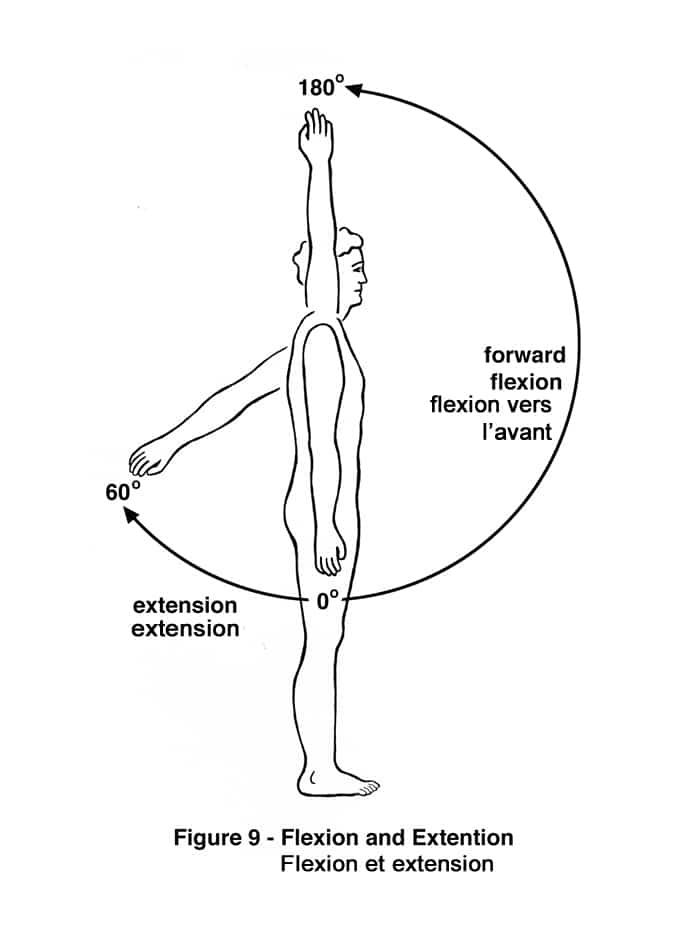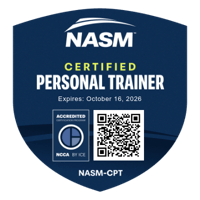Shoulder Flexion Definition
In shoulder flexion, the shoulder joint angle decreases, specifically when you move your arm forward.
For example, when you do a front raise exercise or close grip shoulder press, your arm is rising forward.
This forward movement is called flexion of the shoulder.
The shoulder flexion prime movers are:
- Pectoralis Major Clavicle
- Anterior Deltoid
- Biceps Brachii Short Head
- Coracobrachialis
What are the Shoulder Flexion Muscles?
As you can see, we listed four specific shoulder flexion muscles that you need to know for NASM-CPT.
You need to memorize many muscles for the NASM Certification test.
Memorization, in general, is not an easy task.
Memorizing the muscles that extend the shoulder is even worse.
Everyone memorizes in different ways.
However, here is a tip to help you memorize the shoulder flexion muscles for the NASM Certification test.

How You Can Memorize the Shoulder Flexion Muscles
A mnemonic can help you memorize.
Here is a mnemonic for the shoulder flexion muscles:
P
A
B
C
PABC is an acronym for the muscles involved in shoulder movements:
- The P stands for Pectoralis Major Clavicle.
- The A stands for Anterior Deltoid.
- The B stands for Biceps Brachii Short Head.
- And the C stands for Coracobrachialis.
Wherever you find the Biceps Brachii Short Head, you will find the Coracobrachialis.
You need to drill the following information into your head.
The Pec Major muscles show up in four shoulder joint movements.
They are;
- flexion,
- adduction,
- horizontal adduction, and
- internal rotation.
An Additional Way to Memorize Shoulder Movements
The mnemonic for the shoulder joint movements that recruit the pectoralis major muscles is FADDI.
- F stands for Flexion of the shoulder.
- ADD stands for all adductions of the shoulder.
- I stands for Internal rotation of the shoulder.
- FADDI is a movement of the shoulder joint mnemonic for all shoulder joint movements that involve the pec major.
Once you know these joint movements, you will have an easier time remembering the muscles.
Because each of these joint movements has the pec major.
All you have to do now is remember the rest.
For example:
Shoulder flexion is PABC or pec major clavicle, anterior deltoid, biceps brachii short head, and coracobrachialis.
Shoulder adduction muscles are PBCLTT
Which stands for the pec major sternal, biceps brachii short head, coracobrachialis, latissimus dorsi, teres major, and triceps brachii long head.
- Tip: You will likely find the Teres Major muscle whenever you have the latissimus dorsi.
The horizontal shoulder adduction muscles mnemonic is PABC as well, just like shoulder flexion.
The PABC of horizontal shoulder adduction stands for:
- Pec major,
- Anterior deltoid,
- Biceps brachii short head,
- Coracobrachialis.
Notice that the difference between PABC for shoulder flexion and horizontal shoulder adduction joint movement is the clavicle.
In horizontal shoulder adduction, the P stands for Pectoralis Major.
The entire pectoralis muscle is recruited, not just the Pec Major clavicle.
Think of doing a wide-grip bench press, for example.
Last is the I, which stands for internal rotation of the shoulder.
Internal rotation of the shoulder muscles mnemonic is PSALT:
- The pec major,
- subscapularis,
- anterior deltoid,
- latissimus dorsi, and
- teres major.
So, you have
- PABC,
- PBCLTT,
- PABC, and
- PSALT as mnemonics for FADDI.
Shoulder Planes of Movement
All flexion of the shoulder happens in the Sagittal Plane.
In addition, all flexion and extension of the shoulder also occur in the Sagittal plane.
Last, you must know that all flexion and extension of any joint occurs in the sagittal plane.
While this post is about shoulder flexion, knowing the planes of motion is essential.
This is because NASM expects you to know the planes of motion.
Any time you see flexion or extension, understand that the joint movement occurs in the sagittal plane.
For now, that is all you need to know.
We will soon explain the planes of movement and the degrees of freedom.
These are additional concepts that you need to learn.
Shoulder Flexion Exercise Examples
Here are a few examples of shoulder flexion exercises.
The first is the Close Grip Bench Press.
This uses both shoulder flexion and elbow extension.
If you think a close grip bench press is shoulder extension, that is incorrect.
Think of the movement.
When lying on the bench, your shoulder moves forward and upward as you raise the weight.
Thereby decreasing the angle between the shoulder and the midline of your body.
Any forward arm movement where the arm is moving forward and upward will involve shoulder flexion.
Front Raise VS. Close Grip Bench Press
The close grip bench press is a multi-joint exercise.
This is in contrast to the front raise, which is a single-joint exercise.
In the front raise, you move your arm forward, lifting the weight towards shoulder height, which is another example of shoulder flexion.
The close grip shoulder press is one more example of shoulder flexion.
Again, the muscles for shoulder flexion are PABC:
- Pectoralis Major Clavicle,
- Anterior Deltoid,
- Biceps Brachii Short Head, and
- Coracobrachialis.
Is the Pushup Flexion or Extension of the Shoulder?
The answer is that the Push Up is another example of shoulder flexion and elbow extension as is described in the anatomy of a push-up: ²
“The primary muscle (agonist) for the push-up is the pectoralis major (or pecs).
Your pecs are essentially your chest muscles.
As you lower yourself toward the floor, your pecs lengthen and control the speed of your descent.
As you push back up again, they shorten.
When one muscle contracts, the opposite (antagonist) relaxes, causing movement to occur during your push-up.
This is called reciprocal inhibition.
The main antagonist muscles during a push-up are your trapezius, posterior deltoids, and rhomboids.
These muscles are on the opposite side of the torso in relation to your pecs.
The helper muscles (synergists) used during a push-up are important because they assist the agonist.
The main synergists in the push-up are your triceps and anterior deltoids (or front shoulder muscles).
They assist with elbow extension and shoulder flexion, respectively. ²
What is the Range of Motion for Shoulder Flexion and Extension?
The shoulder flexion range of motion is, on average, 180 degrees.
If you start from the anatomical position of standing tall, your palms are in supination, meaning palms forward.
And you raise your arms forward, as far as you can move them forward and upward.
Most likely, the furthest you can go is till your arms point directly overhead, which is a shoulder flexion range of 180 degrees.
By the way, this is how to present an example of standing shoulder flexion without any weights.
What are the Degrees of Freedom for the Shoulder Joint?
The Degrees of Freedom refer to how many planes of movement a joint has.
For example, the shoulder joint has three degrees of freedom.
Shoulder flexion occurs in the sagittal plane.
This is one degree of freedom, meaning we have one plane of movement.
The same applies to shoulder extension, which occurs in the sagittal plane.
Remember, all shoulder flexion and extension movements occur in the sagittal plane.
This is important for your NASM Certification exam and career as a personal trainer or fitness enthusiast.
Also, shoulder adduction and shoulder abduction happen in the frontal plane.
All adduction and abduction along with lateral flexion (side bends) occur in the frontal plane.
Therefore, shoulder abduction and adduction are in the second degree of freedom, the frontal plane.
Last, the shoulder joint is also capable of horizontal adduction and horizontal abduction.
The shoulder joint can also do internal and external rotation.
All horizontal adduction, abduction, and rotations occur in the transverse plane.
This is a third degree of freedom.
Therefore, the shoulder joint has 3 degrees of freedom.
This means that the shoulder joint can move in 3 planes of movement.
Remember, these shoulder flexion degrees of freedom will likely appear on your NASM-CPT Certification exam.
Watch this brilliant illustration of shoulder anatomy for a complete understanding of the shoulder flexion muscles and the shoulder joint:
Recommended Reading:
- Overhead Squat Assessment: How to Memorize for NASM CPT Exam
- NASM Study Guide for CPT Certification – Pass Your Test!
- What is Kinesiology? Knowing Kinesiology Improves Training
- Calisthenics Bicep Workout: 7 Best Exercises for Bigger Arms
- What is Kinesiology and How it Improves Your Life
Footnotes:
¹ Shoulderstand and Other Precarious Postures – Musicians Health Collective
